A Survey on LoRaWAN Technology: Recent Trends, Opportunities, Simulation Tools and Future Directions
Abstract
:1. Introduction
- (i)
- Conduct a thorough review of the emerging LPWAN technologies, concentrating on their main features and limitations;
- (ii)
- Perform an overview of LoRa/LoRaWAN technologies as a key player for IoT applications, especially in standalone network deployments;
- (iii)
- Examine and compare the commonly used LoRa/LoRaWAN simulation tools by highlighting their capabilities and features for enabling researchers to select the most suitable simulator based on their needs and programming skills;
- (iv)
- Highlight the challenges, recent solutions, and future directions to provide guidelines toward precise deployment of LoRa/LoRaWAN technology as a global network.
2. LPWAN IoT Technologies
2.1. NB-IoT
- (i)
- Standalone: This scenario deploys in a standalone 200-kHz spectrum. For increasing coverage, NB-IoT uses all the transmission power at the base station. The use of this mode will typically be as a substitute for GSM carriers.
- (ii)
- In-band operation: This is deployed in a wideband LTE system, including one or more (180 kHz) LTE physical source blocks. NB-IoT signals must not be transmitted to the region’s LTE-reserved time–frequency tools (including legacy-controlled area signals and reference signals). Wideband LTE and NB-IoT technologies share their transmission power at the base station and can be useful for consuming the same base station hardware with the output of either not being affected [16].
- (iii)
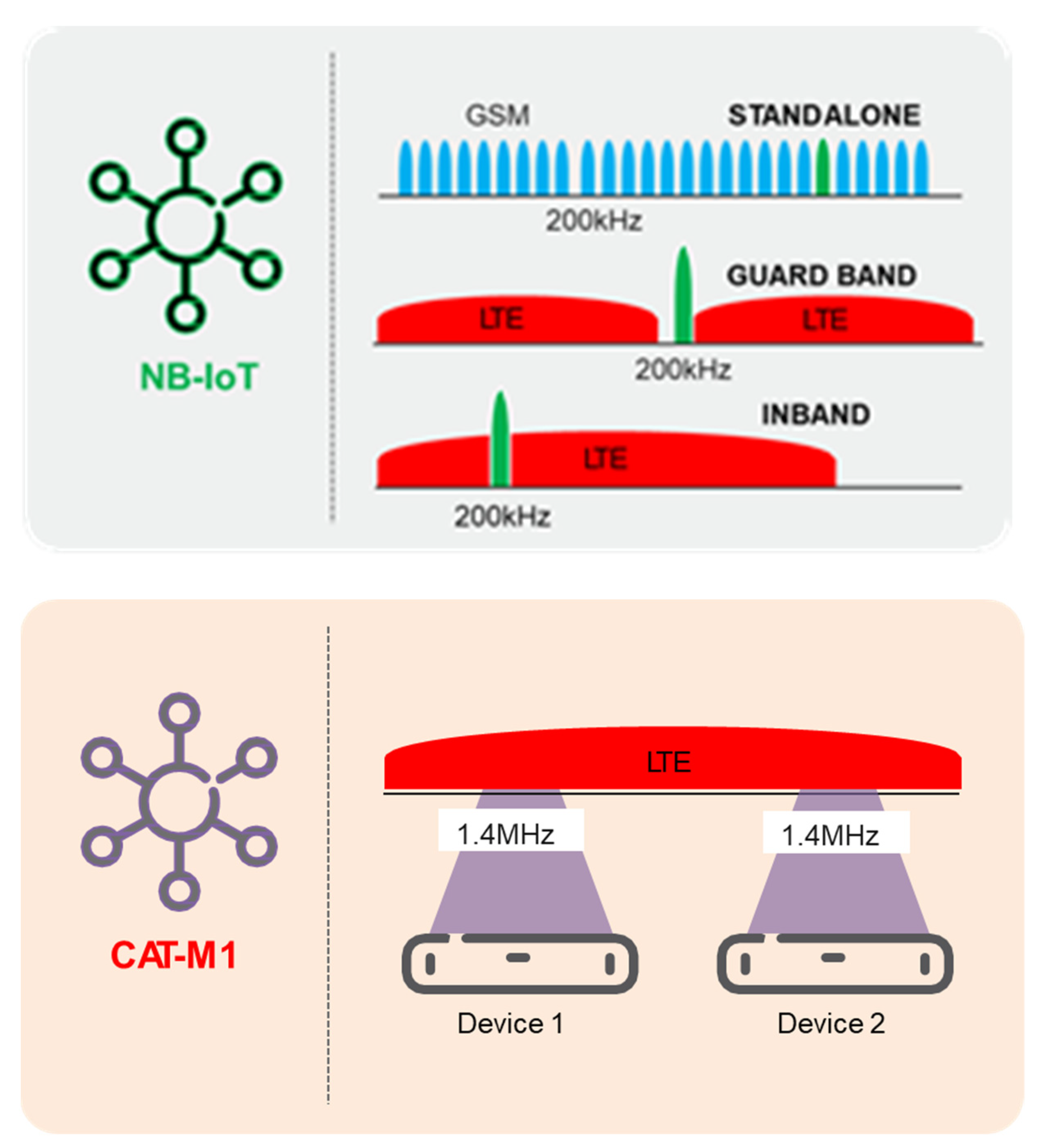
2.2. SigFox
2.3. Telensa
2.4. Ingenu RPMA
2.5. LoRa
3. LoRaWAN Networking
- End devices (ED): These are devices that either take downlink (DL) traffic from the network server or generate uplink (UL) traffic for transmission to the gateways;
- Gateways (GW): These are the devices that demodulate LoRa communication and transmit it between the network server and the end devices in a wireless network. Wired or wireless access points link gateways to the Internet. The LoRaWAN gateway is sophisticated, concurrently listening to the radio on several channels and delivering thousands of ENs simultaneously;
- Network Server (NS): This is the device which serves as the core backend of a LoRaWAN network, collecting traffic from all end devices in the network and processing it on an application server.
- Class A: This class uses two receiving windows at specific times following each UL transmission. As a timing diagram in Figure 8, at the beginning of these receiving windows, only DL transmissions are allowed. With regard to the first window, DL transmissions are carried out using the identical channel and data rate settings as the prior UL transmission. Nevertheless, the second window uses a static setting (i.e., DR0 (SF12/125 KHz)) at 869.525 MHz.
- Class B: This class is an optional mode for ED that needs to receive additional information from the base station as acknowledgment (ACK) that using this mode is better. Despite no former transmission from the EN, the GWs open more reception windows by transmitting synchronization beacons. The number of receiving windows allowed by Class B is more than Class A, but with more energy consumption than Class A. After each UL transmission, the extra regular receiving windows are opened, in addition to the synchronized opening of the two standard receiving windows, called ping slots. The GW beacons are sent periodically every 128 s to guarantee synchronization. The usable beacon window is a time period between two beacons. It is grouped into 212 ping slots of 30 ms, each counting from 0 to 4095 [36].
- Class C: The nodes keep their reception windows open all of the time, only shutting them when the UL sends a packet to one of them. These ENs increase power consumption, since Class C forces the devices to receive constantly, which is incompatible with Class B. The devices that support Class C do not implement Class B.
LoRaWAN Limitations
4. LoRaWAN Issues and Recent Solutions
4.1. Power Consumption
4.2. Pure Data Extraction
4.3. Network Scalability
4.4. Coverage Range and QoS
4.5. Network Security
5. LoRaWAN Simulation Tools
5.1. LoRaSIM
5.2. NS-3
5.3. FLoRa
5.4. CupCarbon
5.5. PhySimulator
5.6. Simulator Comparison
6. Opportunities and Future Research Directions
6.1. Scalability
6.2. Regulation
6.3. Routing and Multi-Hop
6.4. Energy Efficiency
6.5. Security
7. Conclusions
Author Contributions
Funding
Conflicts of Interest
References
- Sisinni, E.; Mahmood, A. Wireless Communications for Industrial Internet of Things: The LPWAN Solutions. In Wireless Networks and Industrial IoT; Springer: Singapore, 2021; pp. 79–103. [Google Scholar]
- Catak, E.; Ata, L.D. An efficient transceiver design for superimposed waveforms with orthogonal polynomials. In Proceedings of the 2017 IEEE International Black Sea Conference on Communications and Networking (BlackSeaCom), Istanbul, Turkey, 5–8 June 2017; pp. 1–5. [Google Scholar]
- Sisinni, E.; Saifullah, A.; Han, S.; Jennehag, U.; Gidlund, M. Industrial internet of things: Challenges, opportunities, and directions. IEEE Trans. Ind. Inform. 2018, 14, 4724–4734. [Google Scholar] [CrossRef]
- Jabbar, W.A.; Shang, H.K.; Hamid, S.N.; Almohammedi, A.A.; Ramli, R.M.; Ali, M.A. IoT-BBMS: Internet of Things-Based Baby Monitoring System for Smart Cradle. IEEE Access 2019, 7, 93791–93805. [Google Scholar] [CrossRef]
- Jabbar, W.A.; Bin Yuzaidi, M.A.; Yan, K.Q.; Bustaman, U.S.B.M.; Hashim, Y.; AlAriqi, H.T. Smart and green street lighting system based on arduino and RF wireless module. In Proceedings of the 8th International Conference on Modeling Simulation and Applied Optimization (ICMSAO), Piscataway, NJ, USA, 15–17 April 2019; pp. 1–6. [Google Scholar]
- Jabbar, W.A.; Saad, W.K.; Hashim, Y.; Zaharudin, N.B.; Abidin, M.F.B.Z. Arduino-based buck boost converter for PV solar system. In Proceedings of the 2018 IEEE Student Conference on Research and Development (SCOReD), Selangor, Malaysia, 26–28 November 2018; pp. 1–6. [Google Scholar]
- Jabbar, W.A.; Kian, T.K.; Ramli, R.M.; Zubir, S.N.; Zamrizaman, N.S.M.; Balfaqih, M.; Shepelev, V.; Alharbi, S. Design and fabrication of smart home with internet of things enabled automation system. IEEE Access 2019, 7, 144059–144074. [Google Scholar] [CrossRef]
- Wang, H.; Fapojuwo, A.O. A Survey of enabling technologies of low power and long range machine-to-machine communications. IEEE Commun. Surv. Tutor. 2017, 19, 2621–2639. [Google Scholar] [CrossRef]
- Wang, Y.-P.E.; Lin, X.; Adhikary, A.; Grovlen, A.; Sui, Y.; Blankenship, Y.W.; Bergman, J.; Shokri-Razaghi, H. A primer on 3GPP narrowband internet of things. IEEE Commun. Mag. 2017, 55, 117–123. [Google Scholar] [CrossRef]
- Zuniga, J.C.; Ponsard, B. Sigfox System Description. Available online: https://www.ietf.org/proceedings/97/slides/slides-97-lpwan-25-sigfox-system-description-00.pdf (accessed on 20 October 2021).
- Sundaram, J.P.S.; Du, W.; Zhao, Z. A Survey on LoRa Networking: Research Problems, Current Solutions, and Open Issues. IEEE Commun. Surv. Tutor. 2019, 22, 371–388. [Google Scholar] [CrossRef] [Green Version]
- Jabbar, W.A.; Ismail, M.; Nordin, R. MBA-OLSR: A multipath battery aware routing protocol for MANETs. In Proceedings of the 2014 5th International Conference on Intelligent Systems, Modelling and Simulation, Langkawi, Malaysia, 27–29 January 2014; pp. 630–635. [Google Scholar]
- Ikpehai, A.; Adebisi, B.; Rabie, K.M.; Anoh, K.; Ande, R.E.; Hammoudeh, M.; Gacanin, H.; Mbanaso, U.M. Low-power wide area network technologies for internet-of-things: A comparative review. IEEE Internet Things J. 2018, 6, 2225–2240. [Google Scholar] [CrossRef] [Green Version]
- Alliance, L. LoRa Alliance. 2021. Available online: www.lora-alliance.org (accessed on 1 April 2021).
- Osorio, A.; Calle, M.; Soto, J.D.; Candelo-Becerra, J.E. Routing in LoRaWAN: Overview and Challenges. IEEE Commun. Mag. 2020, 58, 72–76. [Google Scholar]
- Ratasuk, R.; Mangalvedhe, N.; Zhang, Y.; Robert, M.; Koskinen, J.-P. Overview of narrowband IoT in LTE Rel-13. In Proceedings of the 2016 IEEE Conference on Standards for Communications and Networking (CSCN), Berlin, Germany, 31 October–2 November 2016; pp. 1–7. [Google Scholar]
- Sultan, J.; Mohsen, M.S.; Al-Thobhani, N.S.; Jabbar, W.A. Performance of Hard Handover in 5G Heterogeneous Networks. In Proceedings of the 2021 1st International Conference on Emerging Smart Technologies and Applications (eSmarTA), Sana’a, Yemen, 10–12 August 2021; pp. 1–7. [Google Scholar]
- Yu, C.; Yu, L.; Wu, Y.; He, Y.; Lu, Q. Uplink scheduling and link adaptation for narrowband internet of things systems. IEEE Access 2017, 5, 1724–1734. [Google Scholar] [CrossRef]
- Qin, Z.; Qin, Z.; Li, F.Y.; Li, G.Y.; McCann, J.A.; Ni, Q. Low-power wide-area networks for sustainable IoT. IEEE Wirel. Commun. 2019, 26, 140–145. [Google Scholar] [CrossRef]
- Gomez, C.; Veras, J.C.; Vidal, R.; Casals, L.; Paradells, J. A sigfox energy consumption model. Sensors 2019, 19, 681. [Google Scholar] [CrossRef] [Green Version]
- Queralta, J.P.; Gia, T.; Zou, Z.; Tenhunen, H.; Westerlund, T. Comparative study of LPWAN technologies on unlicensed bands for M2M communication in the IoT: Beyond LoRa and LoRaWAN. Procedia Comput. Sci. 2019, 155, 343–350. [Google Scholar] [CrossRef]
- Raza, U.; Kulkarni, P.; Sooriyabandara, M. Low power wide area networks: An overview. IEEE Commun. Surv. Tutor. 2017, 19, 855–873. [Google Scholar] [CrossRef] [Green Version]
- Augustin, A.; Yi, J.; Clausen, T.; Townsley, W.M. A study of LoRa: Long range & low power networks for the internet of things. Sensors 2016, 16, 1466. [Google Scholar]
- Burns, J.K.; Selcuk Marks, P. Future Use of Licence Exempt Radio Spectrum; Plum Consult: London, UK, 2015; Available online: https://plumconsulting.co.uk/wpdm-package/plum-july-2015-future-use-of-licence-exempt-radio-spectrum-pdf/ (accessed on 21 October 2021).
- Tournier, J.; Lesueur, F.; Le Mouël, F.; Guyon, L.; Ben-Hassine, H. A survey of IoT protocols and their security issues through the lens of a generic IoT stack. Internet Things 2020, 16, 100264. [Google Scholar] [CrossRef]
- Bembe, M.; Abu-Mahfouz, A.; Masonta, M.; Ngqondi, T. A survey on low-power wide area networks for IoT applications. Telecommun. Syst. 2019, 71, 249–274. [Google Scholar] [CrossRef]
- Telensa. Global Smart Street Lighting & Smart Cities: Market Forecast (2020–2029). 2021. Available online: http://www.telensa.com (accessed on 21 October 2021).
- IoTnow. Building Smarter Cities with Low Power Radio Networks. 2016. Available online: https://www.iot-now.com (accessed on 21 October 2021).
- Myers, T.J. Random phase multiple access system with meshing. U.S. Patent 7,773,664, 10 August 2010. [Google Scholar]
- Hornbuckle, C.A. Fractional-N Synthesized Chirp Generator. U.S. Patent 7791415B2, 7 September 2010. [Google Scholar]
- Semtech. SX1272/3/6/7/8: LoRa Modem Designer’s Guide. 2013. Available online: www.semtech.com (accessed on 21 October 2021).
- Attia, T.; Heusse, M.; Tourancheau, B.; Duda, A. Experimental characterization of LoRaWAN link quality. In Proceedings of the 2019 IEEE Global Communications Conference (GLOBECOM), Waikoloa, HI, USA, 9–13 December 2019; pp. 1–6. [Google Scholar]
- Bouguera, T.; Diouris, J.F.; Chaillout, J.J.; Jaouadi, R.; Andrieux, G. Energy consumption model for sensor nodes based on LoRa and LoRaWAN. Sensors 2018, 18, 2104. [Google Scholar] [CrossRef] [Green Version]
- Jabbar, W.A.; Wei, C.W.; Azmi, N.A.A.M.; Haironnazli, N.A. An IoT Raspberry Pi-based parking management system for smart campus. Internet Things 2021, 14, 100387. [Google Scholar] [CrossRef]
- Adelantado, F.; Vilajosana, X.; Tuset-Peiro, P.; Martinez, B.; Melià-Seguí, J.; Watteyne, T. Understanding the limits of LoRaWAN. IEEE Commun. Mag. 2017, 55, 34–40. [Google Scholar] [CrossRef] [Green Version]
- Abdelfadeel, K.; Farrell, T.; Pesch, D. How to Make Firmware Updates over LoRaWAN Possible. In Proceedings of the 2020 IEEE 21st International Symposium on A World of Wireless, Mobile and Multimedia Networks (WoWMoM), Cork, Ireland, 31 August–3 September 2020; pp. 16–25. [Google Scholar]
- Ayoub, W.; Samhat, A.E.; Nouvel, F.; Mroue, M.; Prevotet, J.C. Internet of mobile things: Overview of LoRaWAN, DASH7, and NB-IoT in LPWANs standards and supported mobility. IEEE Commun. Surv. Tutor. 2019, 21, 1561–1581. [Google Scholar] [CrossRef] [Green Version]
- Wu, Y.T.; He, Y.G.; Shi, L.Q. Energy-saving measurement in LoRaWAN-based wireless sensor networks by using compressed sensing. IEEE Access 2020, 8, 49477–49486. [Google Scholar] [CrossRef]
- El Rachkidy, N.; Guitton, A.; Kaneko, M. Collision resolution protocol for delay and energy efficient LoRa networks. IEEE Trans. Green Commun. Netw. 2019, 3, 535–551. [Google Scholar] [CrossRef]
- Abdelfadeel, K.Q.; Abdelfadeel, K.Q.; Zorbas, D.; Cionca, V.; Pesch, D. FREE $—Fine-grained scheduling for reliable and energy-efficient data collection in LoRaWAN. IEEE Internet Things J. 2019, 7, 669–683. [Google Scholar] [CrossRef] [Green Version]
- Bor, M.C.; Roedig, U.; Voigt, T.; Alonso, J.M. Do LoRa low-power wide-area networks scale? In Proceedings of the 19th ACM International Conference on Modeling, Analysis and Simulation of Wireless and Mobile Systems, Malta, Malta, 13–17 November 2016; pp. 59–67. [Google Scholar]
- Lim, J.-T.; Han, Y. Spreading factor allocation for massive connectivity in LoRa systems. IEEE Commun. Lett. 2018, 22, 800–803. [Google Scholar] [CrossRef]
- Zhu, G.; Liao, C.-H.; Sakdejayont, T.; Lai, I.-W.; Narusue, Y.; Morikawa, H. Improving the capacity of a mesh LoRa network by spreading-factor-based network clustering. IEEE Access 2019, 7, 21584–21596. [Google Scholar] [CrossRef]
- Finnegan, J.; Farrell, R.; Brown, S. Analysis and enhancement of the LoRaWAN adaptive data rate scheme. IEEE Internet Things J. 2020, 7, 7171–7180. [Google Scholar] [CrossRef]
- Bankov, D.; Khorov, E.; Lyakhov, A. On the Limits of LoRaWAN Channel Access. In Proceedings of the 2016 International Conference on Engineering and Telecommunication (EnT), Moscow, Russia, 29–30 November 2016; pp. 10–14. [Google Scholar]
- Haxhibeqiri, J.; Moerman, I.; Hoebeke, J.; Abeele, F.V.D. LoRa scalability: A simulation model based on interference measurements. Sensors 2017, 17, 1193. [Google Scholar] [CrossRef] [Green Version]
- Georgiou, O.; Raza, U. Low power wide area network analysis: Can LoRa scale? IEEE Wirel. Commun. Lett. 2017, 6, 162–165. [Google Scholar] [CrossRef] [Green Version]
- Sanchez-Iborra, R.; Gómez, A.S.; Ballesta-Viñas, J.; Cano, M.-D.; Skarmeta, A.F. Performance evaluation of LoRa considering scenario conditions. Sensors 2018, 18, 772. [Google Scholar] [CrossRef] [Green Version]
- Ertürk, M.A.; Aydın, M.A.; Büyükakkaşlar, M.T.; Evirgen, H. A survey on LoRaWAN architecture, protocol and technologies. Future Internet 2019, 11, 216. [Google Scholar] [CrossRef] [Green Version]
- Wu, W.; Li, Y.; Zhang, Y.; Wang, B.; Wang, W. Distributed queueing-based random access protocol for LoRa networks. IEEE Internet Things J. 2020, 7, 763–772. [Google Scholar] [CrossRef]
- Lavric, A.; Popa, V. Performance evaluation of LoRaWAN communication scalability in large-scale wireless sensor networks. Wirel. Commun. Mob. Computing 2018, 2018, 6730719. [Google Scholar] [CrossRef] [Green Version]
- Pop, A.-I.; Raza, U.; Kulkarni, P.; Sooriyabandara, M. Does bidirectional traffic do more harm than good in LoRaWAN based LPWA networks? In Proceedings of the GLOBECOM 2017—2017 IEEE Global Communications Conference, Singapore, 4–8 December 2017; pp. 1–6. [Google Scholar]
- Petajajarvi, J.; Mikhaylov, K.; Roivainen, A.; Hanninen, T.; Pettissalo, M. On the coverage of LPWANs: Range evaluation and channel attenuation model for LoRa technology. In Proceedings of the 2015 14th International Conference on ITS Telecommunications (ITST), Copenhagen, Denmark, 2–4 December 2015; pp. 55–59. [Google Scholar]
- Alves, H.B.M.; Lima, V.S.S.; Silva, D.R.C.; Nogueira, M.B.; Rodrigues, M.C.; Cunha, R.N.; Carvalho, D.F.; Sisinni, E.; Ferrari, P. Introducing a survey methodology for assessing LoRaWAN coverage in Smart Campus scenarios. In Proceedings of the 2020 IEEE International Workshop on Metrology for Industry 4.0 & IoT, Rome, Italy, 3–5 June 2020; pp. 708–712. [Google Scholar]
- El Chall, R.; Lahoud, S.; el Helou, M. LoRaWAN network: Radio propagation models and performance evaluation in various environments in Lebanon. IEEE Internet Things J. 2019, 6, 2366–2378. [Google Scholar] [CrossRef]
- Mroue, H.; Parrein, B.; Hamrioui, S.; Bakowski, P.; Nasser, A.; Cruz, E.M.; Vince, W. LoRa+: An extension of LoRaWAN protocol to reduce infrastructure costs by improving the quality of service. Internet Things 2020, 9, 100176. [Google Scholar] [CrossRef]
- Sallum, E.; Pereira, N.; Alves, M.; Santos, M. Improving quality-of-service in LoRa low-power wide-area networks through optimized radio resource management. J. Sens. Actuator Netw. 2020, 9, 10. [Google Scholar] [CrossRef] [Green Version]
- Garlisi, D.; Martino, A.; Zouwayhed, J.; Pourrahim, R.; Cuomo, F. Exploratory approach for network behavior clustering in LoRaWAN. J. Ambient. Intell. Humaniz. Comput. 2021, 1–15. [Google Scholar] [CrossRef]
- Tsai, K.-L.; Leu, F.-Y.; Hung, L.-L.; Ko, C.-Y. Secure session key generation method for LoRaWAN servers. IEEE Access 2020, 8, 54631–54640. [Google Scholar] [CrossRef]
- Farooq, M.O.; Pesch, D. Poster: Extended LoRaSim to Simulate Multiple IoT Applications in a LoRaWAN. In Proceedings of the International Conference on Embedded Wireless Systems and Networks (EWSN), Madrid, Spain, 14–16 February 2018. [Google Scholar]
- Ali, M.A.; Mailah, M.; Jabbar, W.A.; Moiduddin, K.; Ameen, W.; Alkhalefah, H. Autonomous Road Roundabout Detection and Navigation System for Smart Vehicles and Cities Using Laser Simulator–Fuzzy Logic Algorithms and Sensor Fusion. Sensors 2020, 20, 3694. [Google Scholar] [CrossRef]
- Zorbas, D.; Caillouet, C.; Hassan, K.A.; Pesch, D. Optimal data collection time in LoRa networks—A time-slotted approach. Sensors 2021, 21, 1193. [Google Scholar] [CrossRef]
- Zorbas, D.; Kotzanikolaou, P.; Pesch, D. TS-LoRa: Time-slotted LoRaWAN for the industrial internet of things. Comput. Commun. 2020, 153, 1–10. [Google Scholar] [CrossRef]
- Henderson, T.R.; Roy, S.; Floyd, S.; Riley, G.F. ns-3 project goals. In Proceedings of the 2006 workshop on ns-2: The IP network simulator-WNS2 ’06, Pisa, Italy, 10 October 2006; ACM Press: New York, NY, USA, 2006; p. 13. [Google Scholar]
- Simulator, N. Available online: https://www.nsnam.org (accessed on 20 October 2021).
- Van den Abeele, F.; Haxhibeqiri, J.; Moerman, I.; Hoebeke, J. Scalability analysis of large-scale LoRaWAN networks in ns-3. IEEE Internet Things J. 2017, 4, 2186–2198. [Google Scholar] [CrossRef] [Green Version]
- Bilalb, S.M.; Othmana, M. A performance comparison of network simulators for wireless networks. arXiv 2013, arXiv:1307.4129. [Google Scholar]
- Reynders, B.; Wang, Q.; Pollin, S. A LoRaWAN module for ns-3. In Proceedings of the 10th Workshop on ns-3-WNS3 ’18, Surathkal, India, 13–14 June 2018; ACM Press: New York, NY, USA, 2018; pp. 61–68. [Google Scholar]
- Khan, F.H.; Portmann, M. Experimental evaluation of LoRaWAN in NS-3. In Proceedings of the 2018 28th International Telecommunication Networks and Applications Conference (ITNAC), Sydney, NSW, Australia, 21–23 November 2018; pp. 453–460. [Google Scholar]
- To, T.-H.; Duda, A. Simulation of LoRa in NS-3: Improving LoRa performance with CSMA. In Proceedings of the 2018 IEEE International Conference on Communications (ICC), Kansas City, MO, USA, 20–24 May 2018; pp. 1–7. [Google Scholar]
- Finnegan, J.; Brown, S.; Farrell, R. Modeling the energy consumption of LoRaWAN in ns-3 based on real world measurements. In Proceedings of the 2018 Global Information Infrastructure and Networking Symposium (GIIS), Thessaloniki, Greece, 23–25 October 2018; pp. 1–4. [Google Scholar]
- Stellin, M.; Sabino, S.; Grilo, A. LoRaWAN networking in mobile scenarios using a WiFi mesh of UAV gateways. Electronics 2020, 9, 630. [Google Scholar] [CrossRef] [Green Version]
- Hariprasad, S.; Deepa, T. Improving unwavering quality and adaptability analysis of LoRaWAN. Procedia Comput. Sci. 2020, 17, 2334–2342. [Google Scholar] [CrossRef]
- Khan, F.H.; Jurdak, R.; Portmann, M. A Model for reliable uplink transmissions in LoRaWAN. In Proceedings of the 2019 15th International Conference on Distributed Computing in Sensor Systems (DCOSS), Santorini Island, Greece, 29–31 May 2019; pp. 147–156. [Google Scholar]
- Finnegan, J.; Brown, S.; Farrell, R. Evaluating the scalability of LoRaWAN gateways for class B communication in ns-3. In Proceedings of the 2018 IEEE Conference on Standards for Communications and Networking (CSCN), Paris, France, 29–31 October 2018; pp. 1–6. [Google Scholar]
- Mariusz Slabicki, G.P.; Di Francesco, M. FLoRa—Framework for LoRa. Available online: https://omnetpp.org/download-items/FLoRA.html (accessed on 22 October 2021).
- Available online: https://flora.aalto.fi/ (accessed on 19 October 2021).
- Slabicki, M.; Premsankar, G.; Di Francesco, M. Adaptive configuration of LoRa networks for dense IoT deployments. In Proceedings of the NOMS 2018—2018 IEEE/IFIP Network Operations and Management Symposium, Taipei, Taiwan; pp. 1–9.
- Cupcarbon. Available online: http://cupcarbon.com (accessed on 15 October 2021).
- Lopez-Pavon, C.; Sendra, S.; Valenzuela-Valdés, J.F. Evaluation of CupCarbon network simulator for wireless sensor networks. Netw. Protoc. Algorithms 2018, 10, 1–27. [Google Scholar] [CrossRef]
- Cupcarbon. Cupcarbon User Guide. 2020. Available online: https://cupcarbon.com/cupcarbon_ug.html (accessed on 20 October 2021).
- Lounis, M.; Soler, J.; Marc, O.; Bounceur, A.; Euler, R. 3D Environment for IoT Simulation Under CupCarbon Platform. 2017. Available online: https://www.researchgate.net/publication/319014717_3D_Environment_for_IoT_Simulation_Under_CupCarbon_Platform (accessed on 18 October 2021).
- Sanchez, E.B.; Sadok, D.F.H. LoRa and LoRaWAN protocol analysis using cupcarbon. In Communications in Computer and Information Science; Springer: Singapore, 2020; pp. 352–376. [Google Scholar]
- John, A.; Kumar, T.A.; Adimoolam, M.; Blessy, A. Energy management and monitoring using IoT with CupCarbon platform. In Green Computing in Smart Cities: Simulation and Techniques; Springer: Berlin/Heidelberg, Germany, 2020; pp. 189–206. [Google Scholar]
- Mehdi, K.; Lounis, M.; Bounceur, A.; Kechadi, T. CupCarbon: A multi-agent and discrete event wireless sensor network design and simulation tool. In Proceedings of the Seventh International Conference on Simulation Tools and Techniques, Lisbon, Portugal, 17–19 March 2014; pp. 126–131. [Google Scholar]
- Croce, D.M.G.; Mangione, S.; Santaromita, G.; Tinnirello, I. 2018. Available online: http://lora.tti.unipa.it/ (accessed on 25 October 2021).
- Bardram, A.V.T.; Larsen, M.D.; Malarski, K.M.; Petersen, M.N.; Ruepp, S. LoRaWan capacity simulation and field test in a harbour environment. In Proceedings of the 2018 Third International Conference on Fog and Mobile Edge Computing (Fmec), Barcelona, Spain, 23–26 April 2018; pp. 193–198. [Google Scholar]
- Abbas, A.H.; Audah, L.; Alduais, N.A.M. An efficient load balance algorithm for vehicular ad-hoc network. In Proceedings of the 2018 Electrical Power, Electronics, Communications, Controls and Informatics Seminar (EECCIS), Batu, Indonesia, 9–11 October 2018; pp. 207–212. [Google Scholar]
- Yu, F.H.; Zhu, Z.M.; Fan, Z. Study on the feasibility of LoRaWAN for smart city applications. In Proceedings of the 2017 IEEE 13th International Conference on Wireless and Mobile Computing, Networking and Communications (Wimob), Rome, Italy, 9–11 October 2017; pp. 334–340. [Google Scholar]
- Dalela, P.K.; Sachdev, S.; Tyagi, V. LoRaWAN Network Capacity for practical network planning in India. In Proceedings of the 2019 Ursi Asia-Pacific Radio Science Conference (Ap-Rasc), New Delhi, India, 9–15 March 2019; pp. 1–4. [Google Scholar]
- Farooq, M.O.; Pesch, D. Evaluation of multi-gateway LoRaWAN with different Data traffic models. In Proceedings of the 2018 IEEE 43rd Conference on Local Computer Networks (LCN), Chicago, IL, USA, 1–4 October 2018; pp. 279–282. [Google Scholar]
- Hassan, K. Resource Management and IP Interoperability for Low Power Wide Area Networks. Ph.D. Thesis, University College Cork, Cork, Ireland, 2020. [Google Scholar]
- Abdelfadeel, K.; Cionca, V.; Pesch, D. A Fair Adaptive Data Rate Algorithm for LoRaWAN. In Proceedings of the International Conference on Embedded Wireless Systems and Networks (EWSN 2018), Madrid, Spain, 14–16 February 2018. [Google Scholar]
- Bor, M.; Roedig, U. LoRa transmission parameter selection. In Proceedings of the 2017 13th International Conference on Distributed Computing in Sensor Systems (DCOSS), Ottawa, ON, Canada, 5–7 June 2017; pp. 27–34. [Google Scholar]
- Voigt, T.; Bor, M.; Roedig, U.; Alonso, J. Mitigating Inter-Network Interference in LoRa Networks. In Proceedings of the 2017 International Conference on Embedded Wireless Systems and Networks, Uppsala, Sweden, 20–22 February 2016. [Google Scholar]
- Bor, M.; King, A.; Roedig, U. Lifetime bounds of Wi-Fi enabled sensor nodes. Procedia Comput. Sci. 2015, 52, 1108–1113. [Google Scholar] [CrossRef]
- Bor, M.; Roedig, U. OpenCL as Wireless Sensor Network Programming Abstraction. In Proceedings of the IWOCL 2014, Bristol, UK, 12–13 May 2014. [Google Scholar]
- Ta, D.T.; Khawam, K.; Lahoud, S.; Adjih, C.; Martin, S. LoRa-MAB: A flexible simulator for decentralized learning resource allocation in IoT networks. In Proceedings of the 12th IFIP Wireless and Mobile Networking Conference (WMNC), Paris, France, 1–13 September 2019; pp. 55–62. [Google Scholar]
- Ta, D.; Khawam, K.; Lahoud, S.; Adjih, C.; Martin, S. LoRa-MAB: Toward an intelligent resource allocation approach for LoRaWAN. In Proceedings of the IEEE Global Communications Conference (GLOBECOM), Waikoloa, HI, USA, 9–13 December 2019; pp. 1–6. [Google Scholar]
- Reynders, B.; Wang, Q.; Tuset-Peiro, P.; Vilajosana, X.; Pollin, S. Improving reliability and scalability of LoRaWANs through lightweight scheduling. IEEE Internet Things J. 2018, 5, 1830–1842. [Google Scholar] [CrossRef]
- Magrin, D.; Centenaro, M.; Vangelista, L. Performance evaluation of LoRa networks in a smart city scenario. In Proceedings of the 2017 IEEE International Conference on Communications (ICC), Paris, France, 21–25 May 2017. [Google Scholar]
- Tomic, I.; Bhatia, L.; Breza, M.J.; McCann, J.A. The limits of LoRaWAN in event-triggered wireless networked control systems. In Proceedings of the 2018 Ukacc 12th International Conference on Control (Control), Sheffield, UK, 5–7 September 2018; pp. 101–106. [Google Scholar]
- Croce, D.; Gucciardo, M.; Mangione, S.; Santaromita, G.; Tinnirello, I. Impact of LoRa imperfect orthogonality: Analysis of link-level performance. IEEE Commun. Lett. 2018, 22, 796–799. [Google Scholar] [CrossRef] [Green Version]
- Gucciardo, M.; Tinnirello, I.; Garlisi, D. A cell-level traffic generator for LoRa networks. In Proceedings of the 23rd Annual International Conference on Mobile Computing and Networking, Snowbird, UT, USA, 16–20 October 2017; pp. 474–476. [Google Scholar]
- Marini, R.; Cerroni, W.; Buratti, C. A novel collision-aware adaptive data rate algorithm for LoRaWAN networks. IEEE Internet Things J. 2021, 8, 2670–2680. [Google Scholar] [CrossRef]
- Magrin, D.; Avallone, S.; Roy, S.; Zorzi, M. Validation of the ns-3 802.11 ax OFDMA Implementation. In Proceedings of the Workshop on ns-3, Virtual Event USA, 23–24 June 2021; pp. 1–8. [Google Scholar] [CrossRef]
- Di Vincenzo, V.; Heusse, M.; Tourancheau, B. Improving downlink scalability in loRaWAN. In Proceedings of the ICC 2019-2019 IEEE International Conference on Communications (ICC), Shanghai, China, 20–24 May 2019; pp. 1–7. [Google Scholar]
- Saad, W.K.; Shayea, I.; Hamza, B.J.; Mohamad, H.; Daradkeh, Y.I.; Jabbar, W.A. Handover Parameters Optimisation Techniques in 5G Networks. Sensors 2021, 21, 5202. [Google Scholar] [CrossRef]
- Zhang, C.; Li, O.; Liu, G.; Li, M. A practical data-gathering algorithm for lossy wireless sensor networks employing distributed data storage and compressive sensing. Sensors 2018, 18, 3221. [Google Scholar] [CrossRef] [PubMed] [Green Version]
- Ghaleb, M.; Subramaniam, S.; Ghaleb, S.M. An adaptive data gathering algorithm for minimum travel route planning in WSNs based on rendezvous points. Symmetry 2019, 11, 1326. [Google Scholar] [CrossRef] [Green Version]
- Muteba, F.; Djouani, K.; Olwal, T. A comparative survey study on LPWA IoT technologies: Design, considerations, challenges and solutions. Procedia Comput. Sci. 2019, 155, 636–641. [Google Scholar] [CrossRef]
- Jabbar, W.A.; Ismail, M.; Nordin, R.; Ramli, R.M. EMA-MPR: Energy and mobility-aware multi-point relay selection mechanism for multipath OLSRv2. In Proceedings of the 2017 IEEE 13th Malaysia international conference on communications (MICC), Johor Bahru, Malaysia, 28–30 November 2017; pp. 1–6. [Google Scholar]
- Pham, C.; Ehsan, M. Dense deployment of LoRa networks: Expectations and limits of channel activity detection and capture effect for radio channel access. Sensors 2021, 21, 825. [Google Scholar] [CrossRef]
- Zorbas, D.; O’Flynn, B. Collision-free sensor data collection using LoRaWAN and drones. In Proceedings of the 2018 Global Information Infrastructure and Networking Symposium, Thessaloniki, Greece, 23–25 October 2018; pp. 1–5. [Google Scholar]
- Sharma, V.; You, I.; Pau, G.; Collotta, M.; Lim, J.D.; Kim, J.N. LoRaWAN-based energy-efficient surveillance by drones for intelligent transportation systems. Energies 2018, 11, 573. [Google Scholar] [CrossRef] [Green Version]
- Benites, B.; Chavez, E.; Medina, J.; Vidal, R.; Chauca, M. LoRaWAN applied in swarm drones: A focus on the use of fog for the management of water resources in Lima-Peru. In Proceedings of the 2019 5th International Conference on Mechatronics and Robotics Engineering (Icmre 2019), Rome, Italy, 16–19 February 2019; pp. 171–176. [Google Scholar]
- Delgado, C.; Sanz, J.M.; Blondia, C.; Famaey, J. Batteryless LoRaWAN communications using energy harvesting: Modeling and characterization. IEEE Internet Things J. 2021, 8, 2694–2711. [Google Scholar] [CrossRef]
- Huh, J.-H.; Tanjung, D.; Kim, D.-H.; Byeon, S.; Kim, J.-D. Improvement of multi-channel LoRa networks based on distributed joint queueing. IEEE Internet Things J. 2021. [Google Scholar] [CrossRef]
- Torroglosa-Garcia, E.M.; Calero, J.M.A.; Bernabe, J.B.; Skarmeta, A. Enabling roaming across heterogeneous IoT wireless networks: LoRaWAN meets 5G. IEEE Access 2020, 8, 103164–103180. [Google Scholar] [CrossRef]
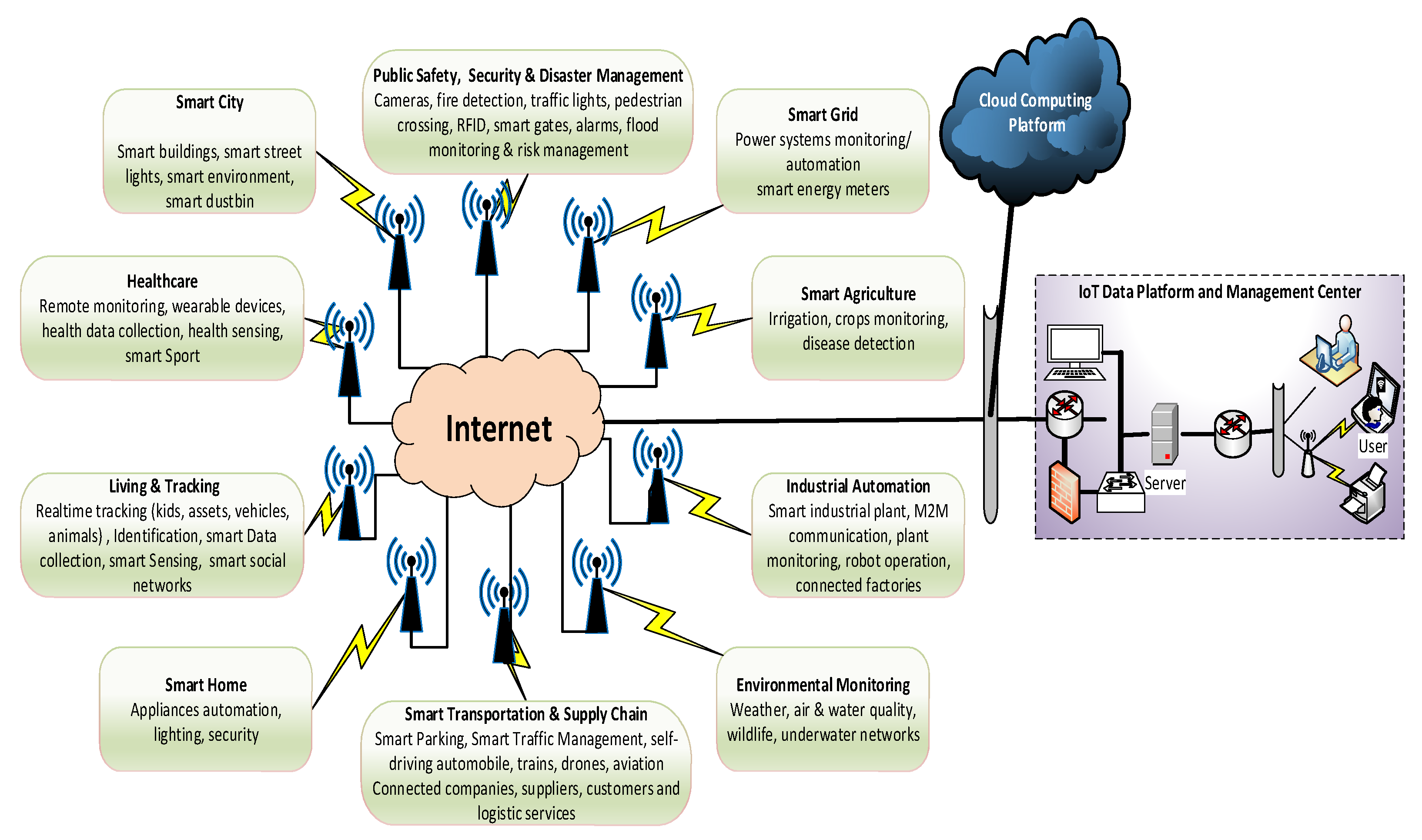
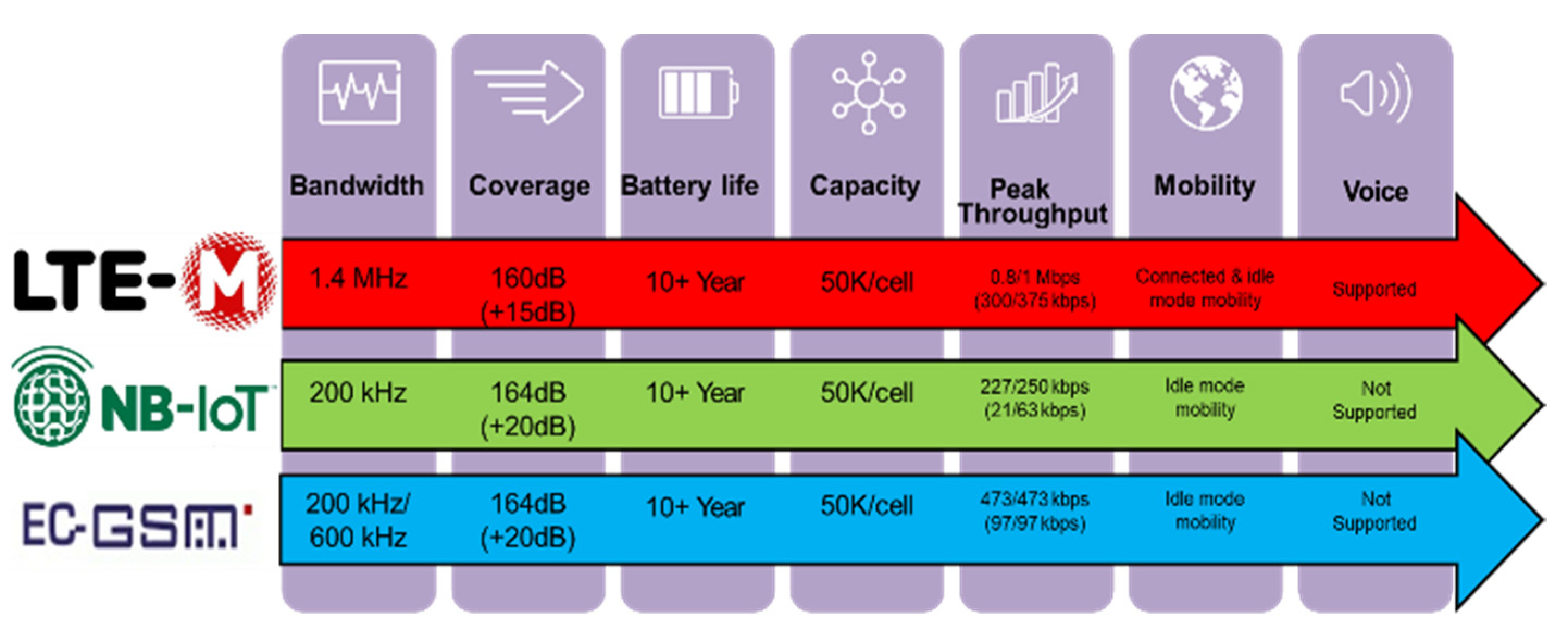
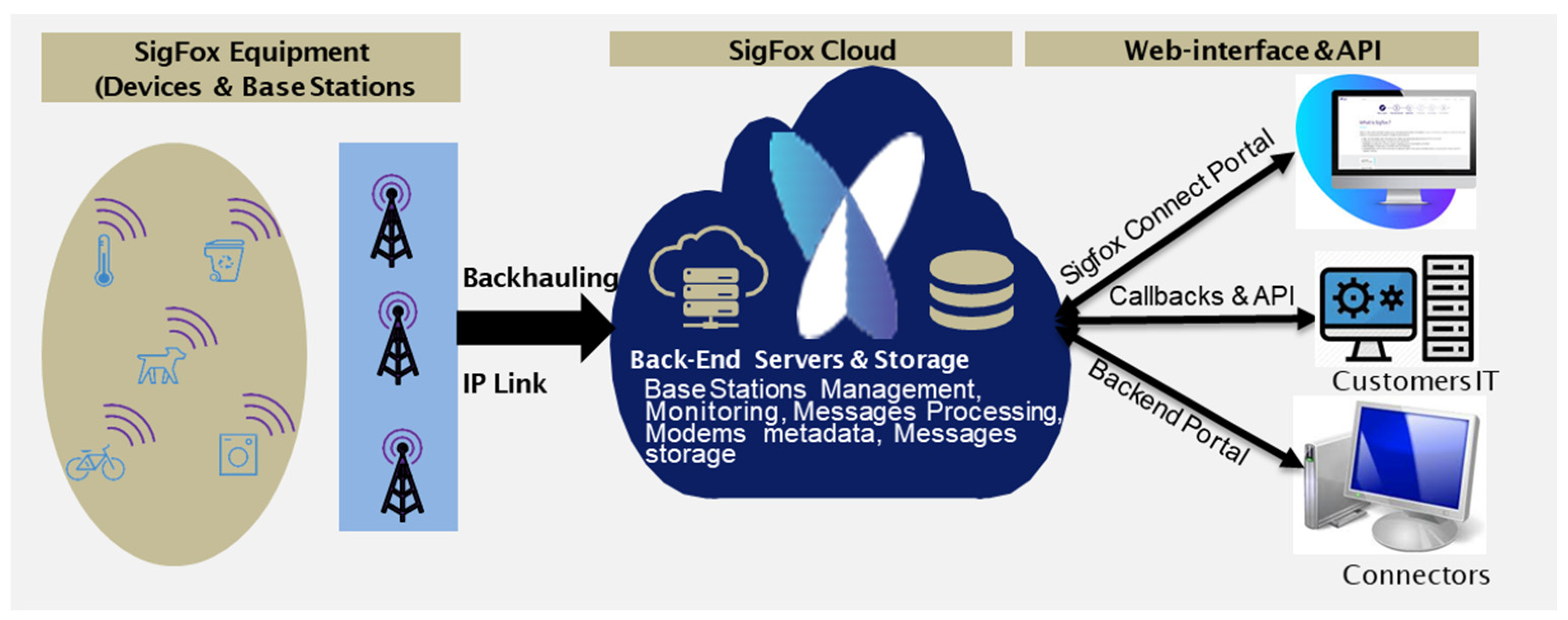

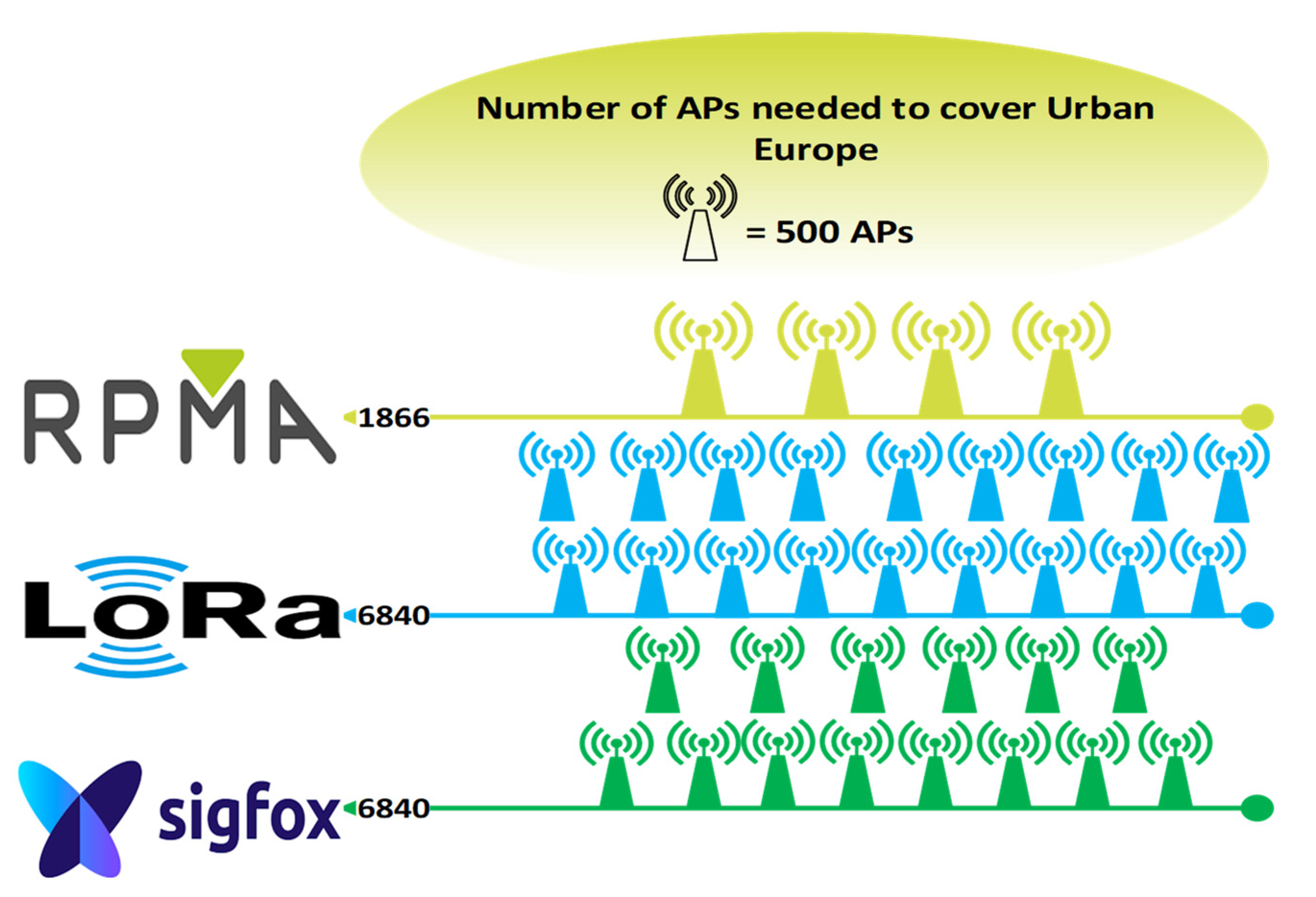
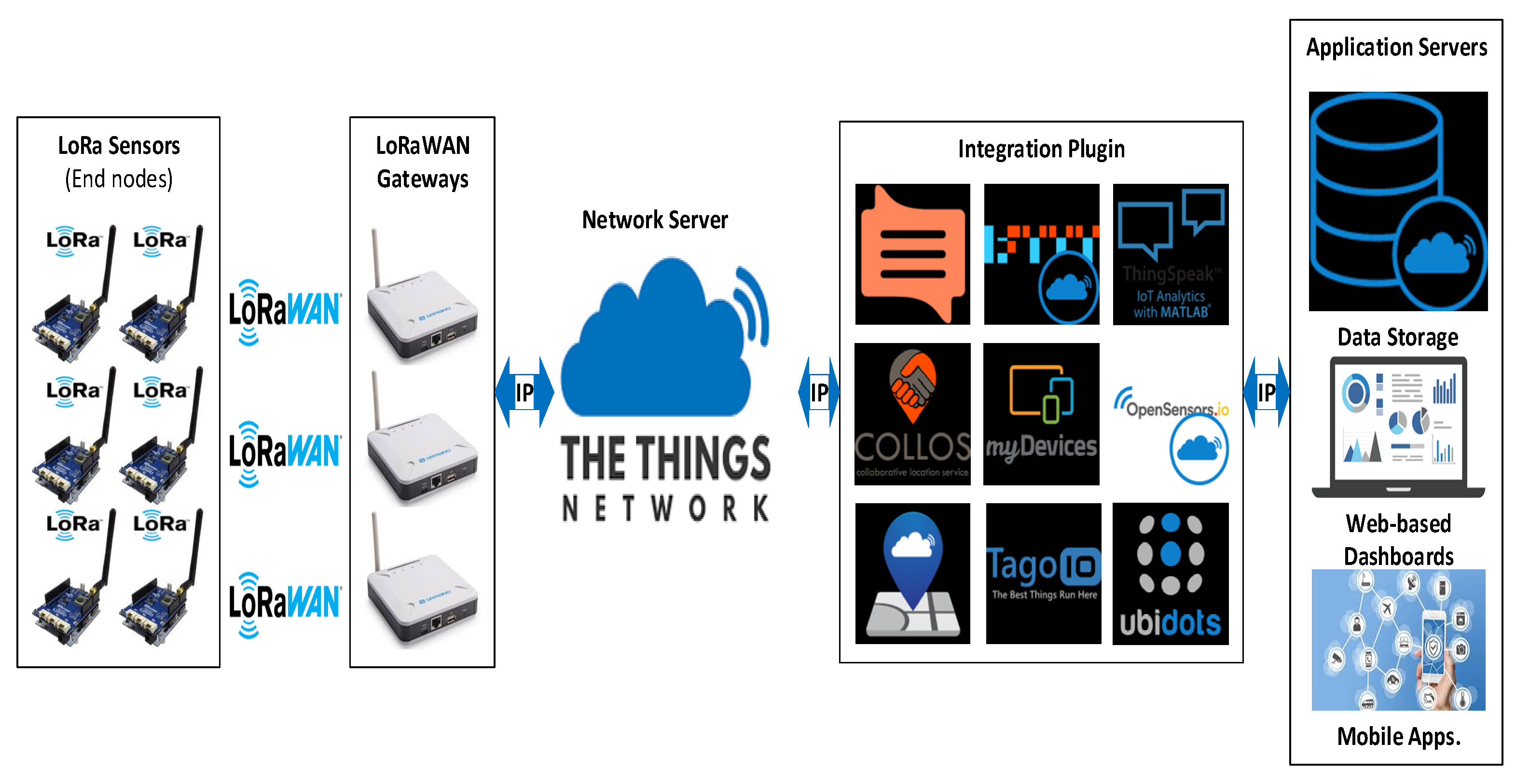



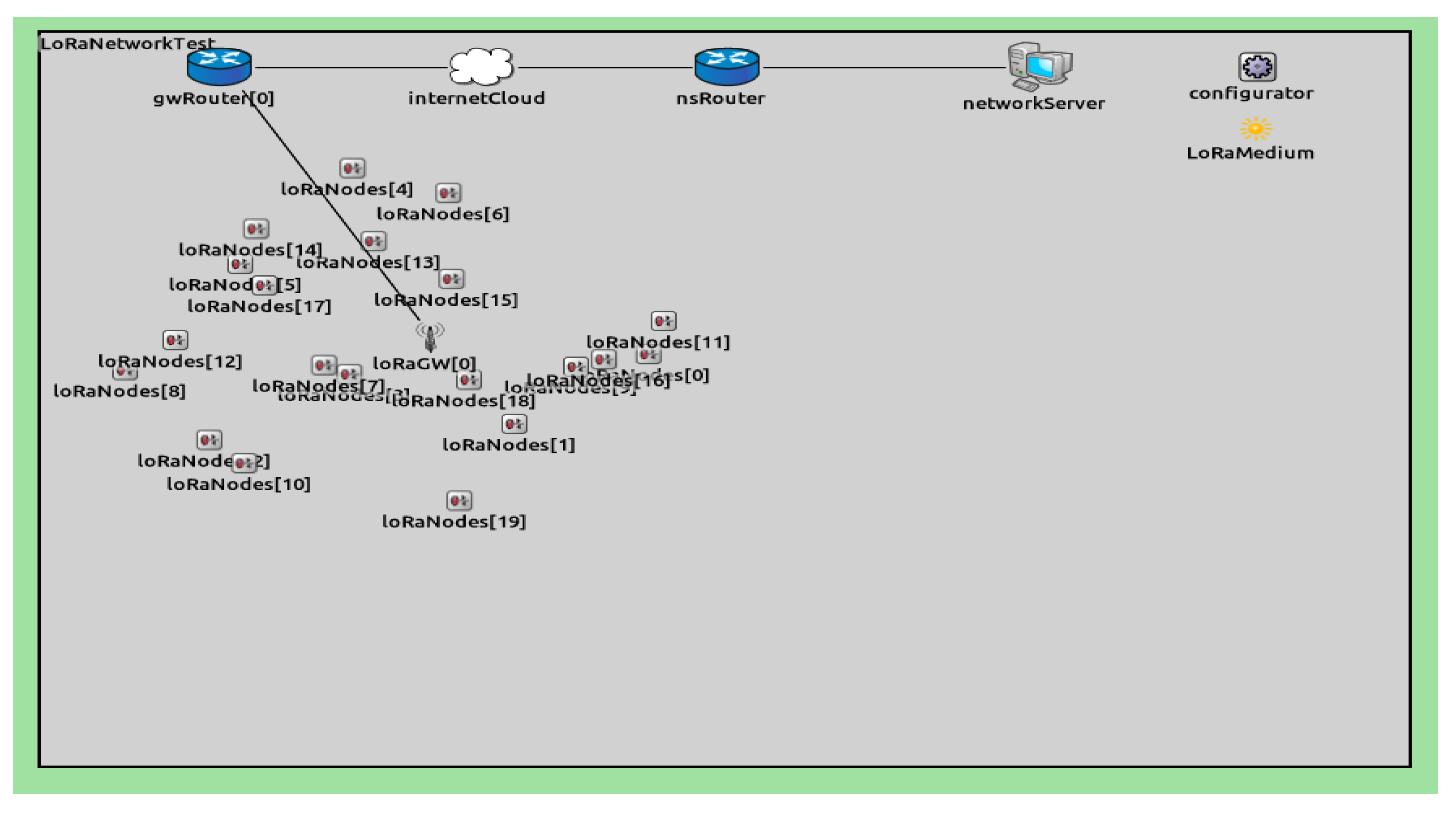
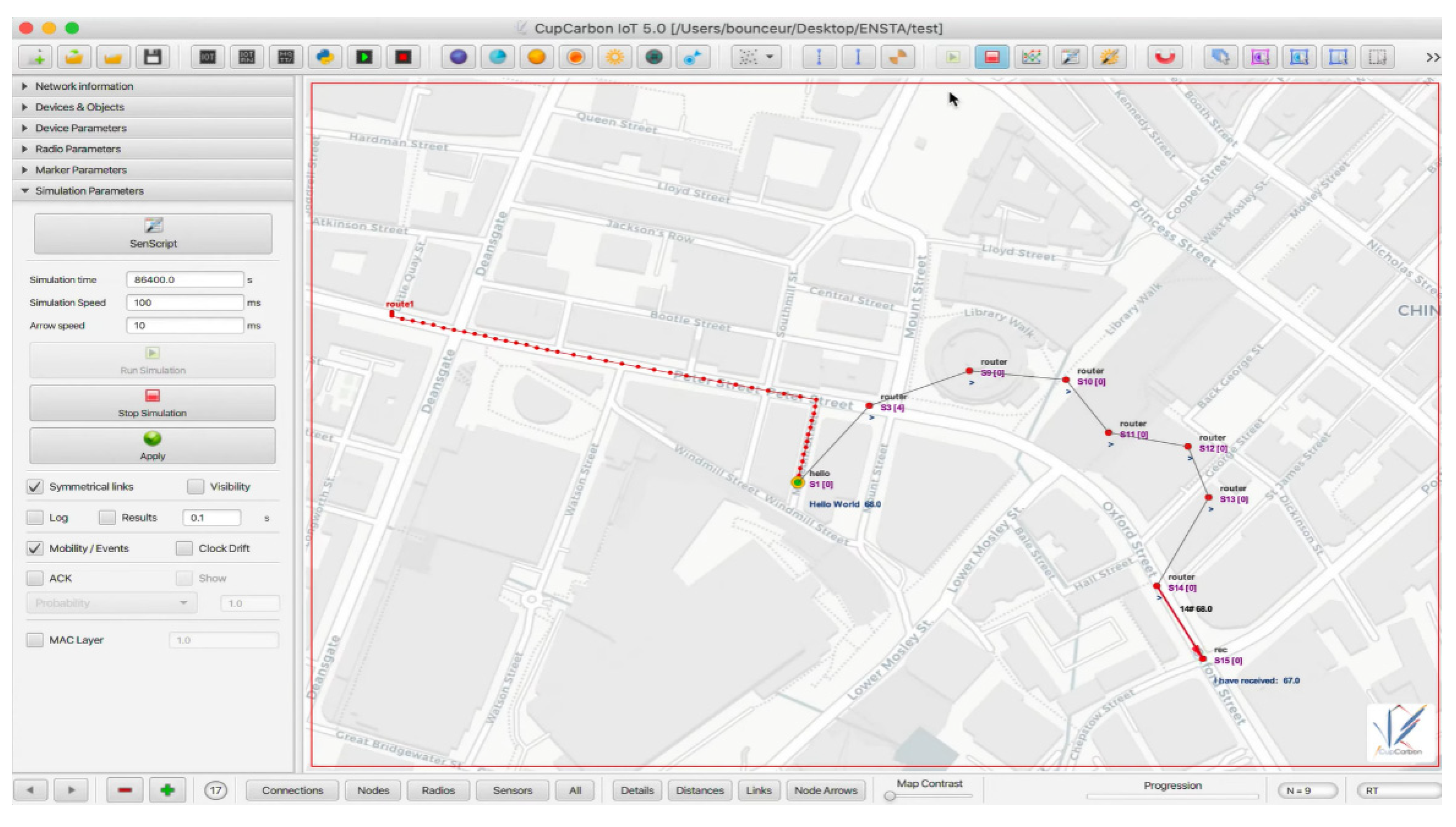
| Property or Technology | NB-IoT | SigFox | Telensa | Ingenu RPMA | LoRa |
|---|---|---|---|---|---|
| Founder | 3 GPP | SigFox | Telensa | Ingenu | Semtech |
| Standard | 3 GPP Release 13 and 14 | SigFox and ETSI LTN | Telensa and ETSI LTN | RPMA and IEEE 802.15.4 K | LoRa Alliance |
| Frequency band | Licensed 7–900 MHz | Sub-GHz ISM EU: 868 MHz US: 902 MHz | Sub-GHz ISM EU: 868 MHz US: 915 MHz AS: 430 MHz | 2.4 GHz ISM | Sub-GHz ISM EU: 868 or 433 MHz US: 915 MHz AS: 430 MHz |
| Bandwidth | 180 kHz | 100 or 600 Hz DL:1.5 kHz | 100 kHz | 1 MHz | 125,250,500 kHz |
| Modulation | DL: QPSK UL: π/4-QPSK, π/2-BPSK, QPSK | UL: UNB DBPSK DL: GFSK | UNB 2-FSK | UL: RPMA- DSSS DL: CDMA | CSS, FSK |
| MAC | TDMA-based MAC | ALOHA MAC | n/a | TDMA-based MAC | LoRaWAN/ALOHA-based |
| Protocol ownership | Standard | Proprietary | Standard | Proprietary | Partially proprietary |
| Data rate | UL: 64 kbps DL: 25 kbps | UL: 100 or 600 bps DL: 600 bps | UL: 62.5 bps DL: 500 bps | UL: 624 kbps DL: 156 kbps | LoRa: 0.3–37.5 kbps, FSK: 50 kbps |
| Range | Urban: 1.5 km Rural: 20–40 km | Urban: 3–10 km Rural: 30–50 km | Urban: 3 km Rural: 16 km (NLOS) | Urban: 15 km Rural: 48 km | Urban: 5 km Rural: 45 km |
| Link budget (dB) | 189 | EU: 162 US: 146 | EU: 161 US: 149 | EU: 168 US: 180 | EU: 151 US: 171 |
| Max. Payload size (bytes) | 13 | UL: 12 DL: 8 | 65k | 64 | 250 |
| Tx power (dBm) | 35 | 24 | 14 | 21 | 21 |
| Security | L2 security | No or encryption at higher level | Yes | AES 256 b | AES 128 b |
| Interference immunity | Low | Very high | Very high | Low | Very high |
| Adaptive data rate | No | No | No | Yes | Yes |
| Localization | No | Yes (RSSI) | No | No | Yes (TDOA) |
| Topology | Star | Star | Star or tree | Star or tree | Star-of-stars |
| Energy consumption | Low | Very low | Low | High | Very low |
| Link symmetry | No | No | No | No | Yes |
| Allow private networks | No | No | No | Yes | Yes |
| Over the air updates | No | No | Yes | Yes | Yes |
| Error Correction | CRC | UL: CRC-16 DL: CRC-8 | Yes | CRC | FEC and CRC-8/16 |
| Channel or orthogonal signal | 12 carrier | 360 | multiple | 40 | EU: 10 US: UL 64+8, DL: 8 + SF |
| Nodes per gateway | 52,000 | >1,000,000 | 5000 | 500,000 | >1,000,000 |
| Cost | Moderate | Moderate | High | Low | Very low |
| Criteria | Class A | Class B | Class C |
|---|---|---|---|
| Access approach | ALOHA | Slotted ALOHA | ALOHA |
| Collision | High | Moderate | Moderate |
| Time of reception | 2 s if ON | Relay on slot time | Always unless transmitting |
| DL latency | High | Moderate | Low |
| Real-time support | No | No | Yes |
| Most of time state | Sleeping | Beacon | Listening |
| Power consumption | Very low | Low | Moderate |
| Features | LoRaSim | NS-3 | FLoRa | CupCarbon | PHY Simulator |
|---|---|---|---|---|---|
| License type | Source is open | Source is open | Source is open | Free (education) | Free |
| Operating system | macOS, Linux, Windows | Linux, Windows | Linux, Windows, macOS | macOS | MacOS, Windows |
| Installation requirements | SimPy, NumPy, matplotlib | Import all libraries online | OMNeT++ 6 and INET 4.3.1 | Java | Matlab |
| Type language | Python | C++, Python | C++ | Java | MATLAB |
| GUI | Only plot | Yes | Yes | 2D or 3D with OSM | Only plot |
| Community support | Limited | Very Good | Limited | Good | Good |
| Last update | 2020 | October 2020 | November 2020 | 2020 | 2020 |
| Last version | n/a | ns-3.32 | 6.0 | 3.8 | n/a |
| Popularity | High | High | Medium | Little | High |
| Studies achieved by simulators | [36,41,61,91,92,93,94,95,96,97,98,99] | [44,66,68,69,70,71,72,73,74,75,100,101] | [76,78] | [80,82,83,84,85] | [56,87,88,89,90,102,103,104,105] |
Publisher’s Note: MDPI stays neutral with regard to jurisdictional claims in published maps and institutional affiliations. |
© 2022 by the authors. Licensee MDPI, Basel, Switzerland. This article is an open access article distributed under the terms and conditions of the Creative Commons Attribution (CC BY) license (https://creativecommons.org/licenses/by/4.0/).
Share and Cite
Almuhaya, M.A.M.; Jabbar, W.A.; Sulaiman, N.; Abdulmalek, S. A Survey on LoRaWAN Technology: Recent Trends, Opportunities, Simulation Tools and Future Directions. Electronics 2022, 11, 164. https://doi.org/10.3390/electronics11010164
Almuhaya MAM, Jabbar WA, Sulaiman N, Abdulmalek S. A Survey on LoRaWAN Technology: Recent Trends, Opportunities, Simulation Tools and Future Directions. Electronics. 2022; 11(1):164. https://doi.org/10.3390/electronics11010164
Chicago/Turabian StyleAlmuhaya, Mukarram A. M., Waheb A. Jabbar, Noorazliza Sulaiman, and Suliman Abdulmalek. 2022. "A Survey on LoRaWAN Technology: Recent Trends, Opportunities, Simulation Tools and Future Directions" Electronics 11, no. 1: 164. https://doi.org/10.3390/electronics11010164
APA StyleAlmuhaya, M. A. M., Jabbar, W. A., Sulaiman, N., & Abdulmalek, S. (2022). A Survey on LoRaWAN Technology: Recent Trends, Opportunities, Simulation Tools and Future Directions. Electronics, 11(1), 164. https://doi.org/10.3390/electronics11010164







